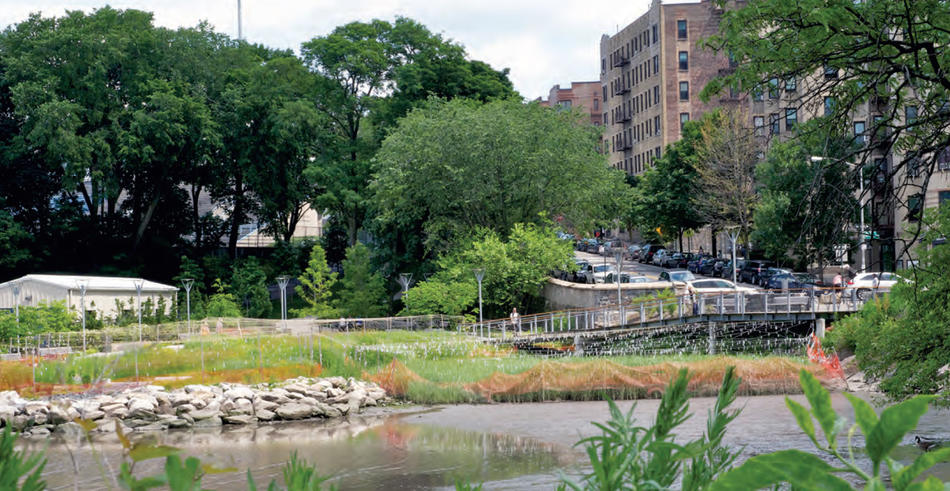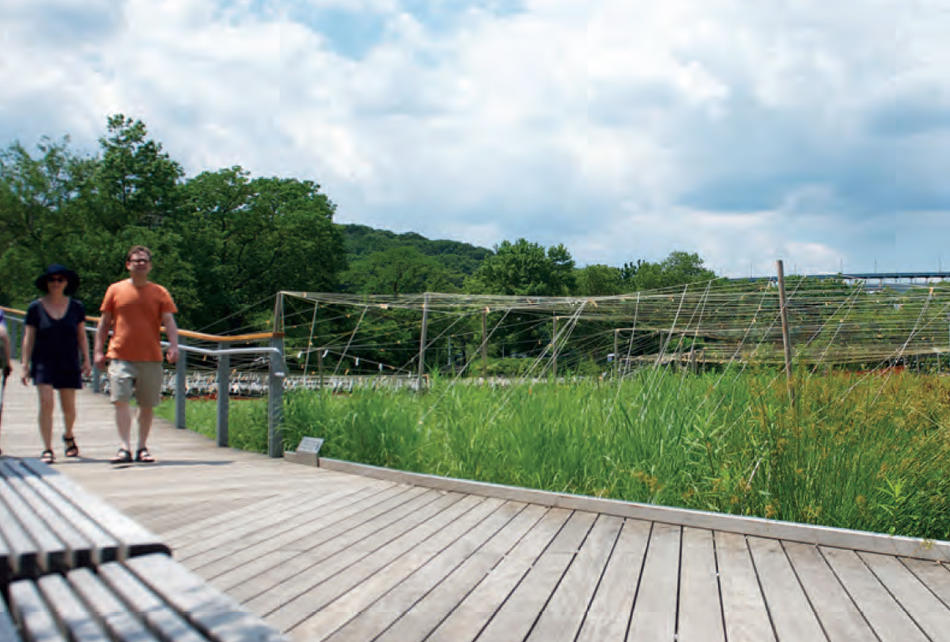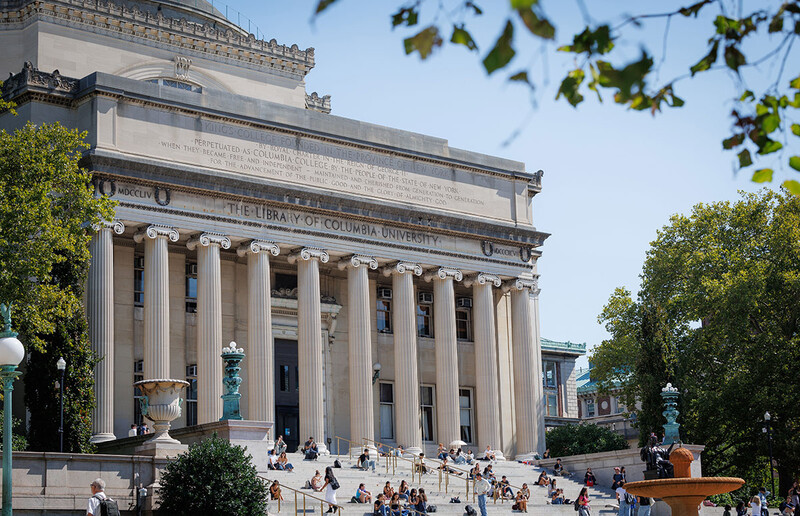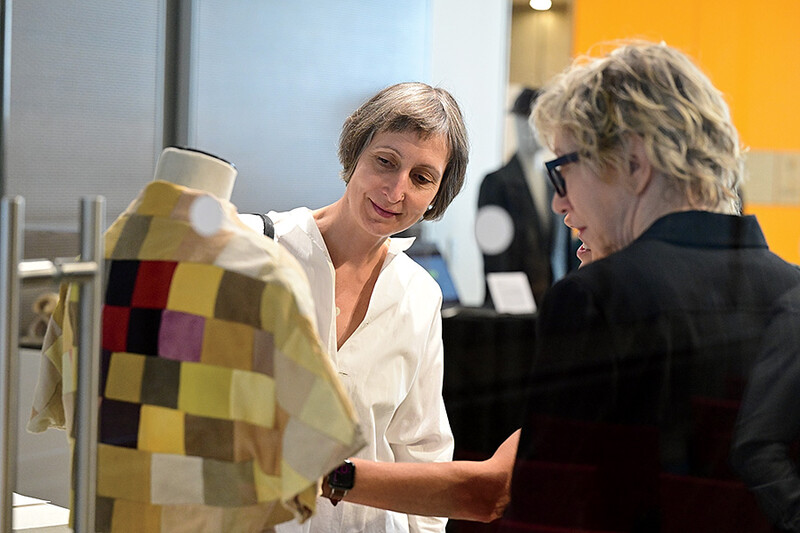Sheila Breslaw grew up in Inwood, the northernmost neighborhood in Manhattan, in the 1950s, and played there within sight of the tidal marsh along the Harlem River. But she rarely ventured down to the shore — not with its overgrown weeds, old tires, and other debris.
Now, on a spring day, she perches on a bench at the muddy inlet as songbirds warble in the trees.
“This is nice, sitting close to the water,” says Breslaw, sixty-seven. “The spot is used a lot more now than when I was a kid.”
The new public park, known as Muscota Marsh, opened this past winter on the western edge of the Baker Athletics Complex, the University’s main outdoor sports compound. Columbia created the park at the same time it built the Campbell Sports Center, a five-story, aluminum-and-glass training facility that opened last year at the corner of Broadway and 218th Street.
Muscota Marsh sits on an acre of land at the northeast tip of Inwood Hill Park and thus extends public access to the Harlem River waterfront by a couple of hundred feet. Although small, the new park is remarkable for encompassing a small inlet whose brackish water is a natural habitat for wading birds, aquatic life forms, and wild grasses that have largely disappeared from Manhattan’s shoreline. One goal of the park is to lure back some of the native wildlife.
“Muscota is not a big place, but it’s quite a diverse place,” says Joseph Mannino, who is Columbia’s vice president for capital-project management. “It’s really become a destination.”
The park was designed by James Corner Field Operations, the landscape-architecture firm that created Manhattan’s High Line aerial greenway and is transforming Staten Island’s Fresh Kills Landfill into an enormous park. The firm won a 2012 design award from the New York City Public Design Commission for its work on Muscota Marsh.
“This new park increases access to the Harlem River waterfront, restores and extends the area’s native marshland adjacent to Inwood Hill Park, and creates an opportunity for increased recreational and educational activities for the community,” says Philip Abramson, a spokesman for the New York City Parks Department, which worked closely with Columbia on the project. (The University maintains the park and provides security for it.)
Originally known as Boathouse Marsh for the Columbia crew facilities located beside it, the area has been renamed Muscota, which means “place in the reeds” in the language of the Lenape, the Native Americans who once lived along its shores.
Muscota’s designers, in addition to expanding the waterfront’s existing tidal marsh, built a new freshwater wetland of cascading pools by installing concrete weirs packed with sand. They planted bulrushes, cardinal flowers, and other native grasses and wildflowers. These plants, together with the sand, filter and cleanse storm-water runoff from nearby streets before it enters the Harlem River.
The project exemplifies a trend in many US cities to build so-called green infrastructure that restores natural areas in part to absorb storm water. “There’s a growing recognition that nature is with us in the city,” says Matthew Palmer, a lecturer in Columbia’s Department of Ecology, Evolution, and Environmental Biology. Muscota and other small urban ecosystems, he says, “provide a pretty good bang for the buck” in healing scarred landscapes.
More than once, nature intervened to delay the project. In 2011, Hurricane Irene eroded a chunk of the inlet and forced designers to rework plans. Then, in October 2012, with 80 percent of construction complete, Hurricane Sandy hit. A six-foot surge of water washed away seedlings, dislodged paving stones, and shorted out underground electrical wiring. The storm set back the park’s opening by several months, to January 2014.
Wildlife is already making itself at home. Canada-goose tracks crisscross the mud flats at low tide. Cormorants, snowy egrets, ducks, seagulls, great blue herons, and leopard frogs feast on an aquatic smorgasbord of insects, ribbed mussels, dragonflies, crabs, and small fish.
“One thing we have learned over the last thirty years is that you can, effectively, play God — you can make a salt marsh,” says Adrian Benepe ’81JRN, a senior vice president of the Trust for Public Land, who worked on the project when he was the New York City parks commissioner. He calls Muscota “a terrific opportunity” to restore a little piece of Manhattan waterfront that since the Dutch first settled there in 1624 has been “re-engineered for commerce” and lost 90 percent of its original wetlands.
Muscota is attracting lots of people, too.
Visitors descend from street level along a steep, tree-shaded gravel path and down a boomerang-shaped wooden walkway that hugs the salt marsh. Benches line a lighted, wheelchair-accessible observation deck that leads to a floating dock from which people can launch canoes and kayaks.
It’s the same dock used by the University’s crew team. Indeed, the park looks out over the famous “C rock,” with its painted blue Columbia varsity “C.” Visible also are the soaring Henry Hudson Bridge and the New Jersey Palisades.
Palmer, the urban ecologist, has already taken sixth graders from nearby Intermediate School 52 on field trips to Muscota Marsh to study the environment.
“They think of a park as a place to visit, with playing fields and nice vistas,” he says, but not about “how plants and animals in these parks are living their own lives.”
He plans to enlist the students and adult “citizen scientists” to visit regularly and keep scientific records of the changing plant and wildlife scene over time.
In the meantime, neighborhood resident Ross Williams is here for the fun.
“When the tide’s in, we see fish, the birds come in — geese, ducks, gulls,” says the forty-three-year-old arts instructor as he watches his three-year-old daughter Laika and a friend play on the observation deck. “It’s great to have a new place to come to.”






